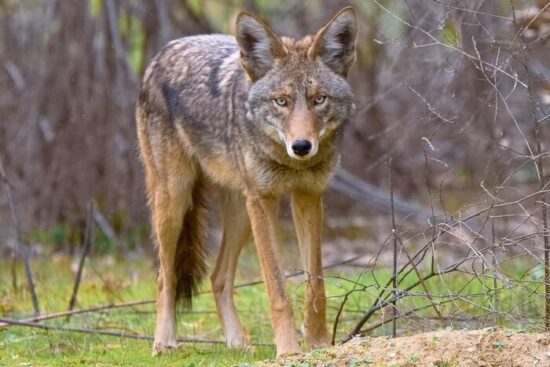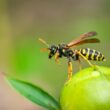There are a number of deterrents that you can use to scare off coyotes. But some of the methods are far more effective than others.
This guide will teach you how to keep coyotes away and ensure that your property stays safe.
1. Clean Up Your Property
One of the worst things you can do if you want to deter coyotes is let your yard become messy and unkempt. Overgrown vegetation and tons of yard debris are an open invitation for coyotes to move on in.
These canines love hiding out in tall grass and heavy vegetation. They’re always looking for new places to lay unseen as they scavenge for food. As a result, a poorly maintained property is like a coyote magnet!
Tall grass and dense shrubbery are particularly troublesome. You see, coyotes often travel in packs. It’s when they feel most confident and safe to brave unknown territory.
When they’re alone, coyotes rely on ground cover to remain unseen. Most coyotes are too weak to take on large predatory animals on their own. So, they adopt a stealthier approach when exploring new areas like your yard.
A messy yard provides the coverage they need. Keep your property clean and remove as many potential hiding spots as possible. Trim back overgrown bushes, prune trees, and keep the lawn mowed.
Quick Tip: It’s a good idea to pay attention to everyday yard debris as well. Leaves and dry plants can accumulate pretty quickly. Eventually, you’ll have huge piles that block your view and provide adequate coverage for coyotes.
Stick to routine yard maintenance, and your property will become less enticing to these wild canines.
2. Minimize Attractants
In addition to keeping your yard nice and tidy, pay attention to all potential attractants! Many items can draw coyotes to your domain. These creatures are on the constant hunt for food and shelter.
While you might not think that a bag of trash sitting on your back porch will be a huge issue, a roving coyote will quickly jump at the opportunity to wreak havoc!
Let’s start with the most obvious attractants. Your outdoor trash bin is teeming with smells that coyotes can’t resist. To keep coyotes away, invest in secured bins that offer a tight seal.
The goal here is to prevent the smell from wafting around and catching the attention of a hungry coyote. Don’t stop there!
These scavengers are more than capable of destroying basic plastic bins. Take your trash security up a notch by investing in metal lock boxes or cages. There’s no shortage of coyote-proof solutions out there, so don’t hesitate to try some out!
The same security measures should apply to compost piles, too. Many homeowners forget to think about that steaming pile of decaying organic matter they have in their backyard. Coyotes getting into your compost isn’t a huge deal as far as messes are concerned.
But giving them free rein of that pile of food scraps will only train them to come back. Lock it up to ensure that they can’t gain access.
Next, think about smaller attractants you might have lying around your property. Some overlooked examples include food for outdoor pets, livestock food dishes.
Store as many of those items away before the sun sets if possible. Lock up bags of dry kibble and take in empty food dishes that might have some lingering smells. You’ll be surprised by how much of a difference getting rid of those attractants can make.
3. Put Up A Good Fence
A solid fence is one of the best coyote deterrents out there. However, standard barriers won’t do since coyotes can jump fences.
But how high can coyotes jump?
Coyotes are fully capable of leaping several feet into the air. On top of that, they can use their agile legs to scale tall fences without missing a beat! As a result, standard six-foot fences are no match for these canines.
There are many factors you have to consider when installing a fence as a coyote deterrent. You want it to be tall enough to prevent coyotes from jumping over, but you also have to address their innate climbing abilities.
For height, aim for a fence that’s at least seven feet tall. Choose a solid fencing material to ensure that coyotes can’t scale the wall and overcome that height. Avoid chain link or vertical slats, as they’ll only serve as ladder rungs for perseverant coyotes.
Instead, try a flat and smooth finish. You can use vertical wood slats, large fence panel systems, or even smooth concrete. Designs with few textures and no potential footholds offer the best results.
Don’t forget about the ground below. When coyotes can’t jump over the fence to get food, they might try to dig below it. To prevent that, extend the fence to a foot or two below ground level.
You can also bury some chicken wire or metal grates several feet out from the base to keep coyotes away.
Quick Tip: If you already have a fence, or simply want to make your new one as secure as possible, you can always install some extenders. Fence extenders sit on top of the barrier and protrude about 45 degrees out. If a coyote were able to scale your wall, they’d encounter the extender and be unable to jump over.
4. Start Hazing
Hazing is a unique way to scare off coyotes. If you’re unfamiliar with the technique, it’s basically training the wild canine to stay fearful of you!
How coyotes respond to humans can vary pretty dramatically. Some will flee at the very sight of you. Others, however, are more daring and aggressive. Ultimately, the response depends on past experiences the coyote had with human interaction.
The goal with hazing is to make every interaction unpleasant or frightening! You don’t want these pests to get too comfortable being around you. Hazing will scare and teach them not to mess with you, which decreases the chances of their return.
Most experts recommend utilizing hazing techniques every time you see a coyote. Don’t wait until it’s already had time to get cozy in your backyard. You want to make your presence known long before the coyote even attempts to step foot in your yard!
The sky’s the limit here, but the go-to for most is to be loud and annoying. Yell at the vermin, bang pots and pans, and wave your arms like a madman! Make yourself seem as large and intimidating as possible to scare off coyotes.
If you have plenty of distance between you and the coyote, you can also throw objects on the ground near them.
Quick Tip: Of course, be careful and exercise caution to avoid agitating the coyote too much. You want the pest to flee in fear, not stand up to you and become aggressive. There’s a fine line here, so try to avoid causing any physical harm that might trigger an attack.
Your goal is to deter coyotes by overwhelming their senses and make the area around your house a bit scary for these canines.
5. Use Sound To Your Advantage
We touched on this a little bit when discussing hazing, but there’s so much more you can do to scare off coyotes. Coyotes hate loud noise. It terrifies them to no end, so you can easily use noise to your advantage.
Try banging some pots together, blasting an air horn, or blowing a whistle. Any sudden noise you make will make your property that much more unappealing!
If you’re vigilant about making a racket, you shouldn’t have any trouble about keeping coyotes away from your property. It’s a form of negative training that works wonders against these wild animals.
All that said, noise is only an effective coyote deterrent if you’re lucky enough to catch them when they get close. If they have a chance to get in undetected without the noise, they’ll learn to disassociate it with your yard.
Luckily, there are some ways to keep the racket coming when you’re not around. Sensor-based alarms are pretty cheap and easy to install. Like standard security systems, they rely on motion to trigger the alarm.
Once a coyote gets near, the alarm will ring and deliver a piercing sound that irritates the senses and sends the pest running!
Quick Tip: Low-tech options are available as well. You can hang bells or wind chimes throughout your property to create a constant stream of noise that the vermin hates. Whatever method you choose, taking advantage of sound is surprisingly effective.
6. Have Some Guard Animals
Coyotes are natural predators that can display plenty of aggression when faced with danger. While many believe that they’re intimidating predators, they aren’t always the top dog.
One great way to keep coyotes away is to have a guard dog keep watch of your property. Guard dogs can serve a couple of different roles.
First, they stand watch throughout the night when coyotes are most active. Dogs are just as cunning as coyotes and are fully capable of detecting their presence when they get near. Once they spot the coyote, your guard dog can jump into action to defend the property, keep livestock safe, and alert you.
Some dogs will go straight to the offensive, lunging directly at the intruder and scaring them off with a bite. However, others will resort to barking. Remember, loud noises are a great way to scare off coyotes! As a result, even dogs with more bark than bite can be super helpful!
Another critical role guard dogs can serve is that of livestock protectors. Many breeds have a long history of protecting sheep or cattle. They can round them up to guide them to safety or jump into action to defend them when predators get near. Either way, their instinctive nature to keep livestock safe makes all the difference!
As you might have guessed, not every dog is up for the task. If you’re thinking about getting a guard dog to keep coyotes out, you need to choose a breed that’s up for the task!
Some of the best dog breeds for the job include:
- Cane Corso
- Mastiffs
- Komondors
- Sheepdogs
- Shepherds
- Kangal
- Rottweiler
Quick Tip: Training is a must. Most working dogs are pretty easy to train, but they require guidance to reach their full potential. Adopt your own commands or work with a professional trainer to ensure that your dog is always ready to face a hungry coyote.
7. Try Coyote Repellent
Like most canines, coyotes rely on their sense of smell for just about everything. They sniff around to find food and are usually drawn to yards because of the enticing aroma of garbage nearby. Use their strong senses to your advantage!
Most repellents assault a coyote’s senses to make your property uninhabitable. You have several options here. If you want to go on the offensive, try using repellents that irritate their sense of smell.
Some of the best repellents to keep coyotes away are ammonia, mothballs, vinegar, and pepper.
To use ammonia, soak some old rags or cotton balls. Place the ammonia-soaked item in crucial areas around your property where coyotes might venture. For example, you can place some at the bottom of the trash can or next to the fence line.
You can do the same with mothballs and pepper powder. Mothballs slowly release gas vapors that irritate the senses. Meanwhile, cayenne pepper powder can cause a world of discomfort for coyotes that are unlucky enough to take a sniff!
Vinegar is offensive as well. You can create a spray mixture with white vinegar and water. Once combined, spray your yard to create an invisible barrier to protection.
Commercial repellents are available as well. You can find offensive-smelling sprays that deter all kinds of pests. In addition to coyotes, they might keep raccoons and other household pest animals away.
Some products also utilize urine or pheromones. These sprays mimic the natural smells of coyote predators, such as wolves. When the coyote smells the urine or pheromones, they’ll avoid the area because they think the danger is nearby.
All coyote repellents only provide temporary results. Sprays can evaporate or wash away with heavy rains. If you plan to try a repellent, make sure to reapply regularly if you want to keep them away in the long term.
8. Keep Pets & Animals Inside
Coyotes are natural-born predators. They hunt down small animals, presenting an ever-growing threat for small pets and livestock.
While coyote deterrents are great ways to keep these animals away, there’s no need to entice them unnecessarily. Bring all of your pets inside at night. We’re not talking about your guard dog here. They can stay outside to protect your property, but those smaller cats and dogs need to stay indoors after the sun goes down.
Like we mentioned earlier, make sure to bring their food dishes inside as well.
It’s a good idea to keep a watchful eye on small pets during the day as well. Coyotes like to observe prey before they hunt them down. While you might not see them, there could be watchful coyotes near your property.
Coyotes are fully capable of learning schedules and figuring out when you let your dog out for their afternoon potty break. If you step back inside and leave your dog out on its own, it can quickly become coyote food!
But what about livestock? Coyotes are notorious for killing chickens, sheep, and other small farm animals. They’ll also hunt down young cattle, calves, and vulnerable mothers that just gave birth.
The best thing you can do for livestock is to keep them fenced up at night. Don’t let them wander around unsupervised. Set up a solid fence to create a wall hungry coyotes can’t get through, and consider getting a guard dog.
For smaller animals, such as ducks or chickens, try using a coop! Lock the coop up at night to keep your precious egg-layers out of harm’s way.
9. Bother Them With Water
We already know that coyotes are skittish and can be scared off by loud noises. But did you know that they also detest water? Coyotes will drink the stuff, but they don’t like getting it in their fur.
Once again, you can use that tidbit of information in your fight against coyotes.
When you see a coyote getting close to your property, turn the water hose on them! Spray them with water as part of your hazing efforts. If you’re lucky enough to douse them, most coyotes will avoid your property like the plague!
You can also run sprinklers throughout the day as an effective coyote deterrent. With some careful positioning, it’s not too difficult to maximize water coverage. Several sprinklers can turn your yard into a minefield where it’s impossible for coyotes to stay dry.
If you want to take things a step further, set up some motion-detection sprinklers. The sprinklers will blast the area with water the moment a coyote crosses the threshold. Turn them on at night to haze these pests even when you’re sleeping.
Quick Tip: Many homeowners like to make water sprinklers just one part of a more comprehensive strategy to keep coyotes away. Combine the sprinkler with audible alarms and bright lights! All of those protective systems will assault the senses and make any daring coyote run for the hills.
Final Thoughts
We hope you found this list of coyote deterrents helpful and use it to keep these animals away. As you probably learned, a simple fence won’t cut it.
Coyotes can jump fences, and require a specialized fence and a variety of deterrents in order to be scared off. As long as you stick with the recommendations and methods on this list, you should have success keeping your yard coyote-free.


